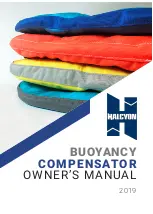
44
MODEL SOLU COMP II
SECTION 8.0
TROUBLESHOOTING
8.3.3 Sensor can be calibrated, but the current is too low
A. Is the temperature low? Sensor current is a strong function of temperature. The sensor current decreases
about 3% for every °C drop in temperature.
B. Sensor current depends on the rate of sample flow past the sensor tip. If the flow is too low, ozone readings
will be low. Refer to the sensor instruction sheet for recommended sample flows.
C. Low current can be caused by lack of electrolyte flow to the cathode and membrane. See step D in Section
8.3.2.
D. Is the membrane fouled or coated? A dirty membrane inhibits diffusion of ozone through the membrane, reduc-
ing the sensor current and increasing the response time. Clean the membrane by gently wiping it with a soft
tissue.
E. If cleaning the membrane does not improve the sensor response, replace the membrane and electrolyte solu-
tion. If necessary, polish the cathode. See the sensor instruction sheet for details.
8.3.4 Process readings are erratic
A. Readings are often erratic when a new sensor or a rebuilt sensor is first placed in service. The current usual-
ly stabilizes after a few hours.
B. Is the sample flow within the recommended range? High sample flow may cause erratic readings. Refer to the
sensor instruction sheet for recommended flow rates.
C. Are the holes between the membrane and the electrolyte reservoir open. Refer to Section 8.3.2.
D. Verify that wiring is correct. Pay particular attention to shield and ground connections.
E. Is the membrane in good condition and is the sensor filled with electrolyte solution? Replace the fill solution
and electrolyte. Refer to the sensor instruction manual for details.
8.3.5 Readings drift
A. Is the sample temperature changing? Membrane permeability is a function of temperature. The time constant
for the 499AOZ sensor is about five minutes. Therefore, the reading may drift for a while after a sudden tem-
perature change.
B. Is the membrane clean? For the sensor to work properly, ozone must diffuse freely through the membrane. A
coating on the membrane will interfere with the passage of ozone, resulting in slow response. Clean the mem-
brane by gently wiping it with a soft tissue.
C. Is the sample flow within the recommended range? Gradual loss of sample flow will cause a downward drift.
D. Is the sensor new or has it been recently serviced? New or rebuilt sensors may require several hours to sta-
bilize.
8.3.6 Sensor does not respond to changes in ozone level.
A. Is the grab sample test accurate? Is the grab sample representative of the sample flowing to the sensor?
B. Is the membrane clean? Clean the membrane and replace it if necessary. Check that the holes at the base of
the cathode stem are open. Use a straightened paper clip to clear blockages. Replace the electrolyte solution.
C. Replace the sensor.







































